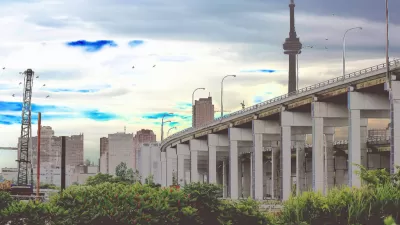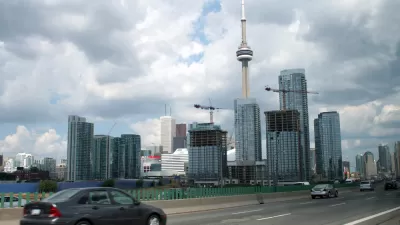As it rebuilds the Gardiner Expressway, Toronto could use the opportunity to create more real estate for affordable housing.

As it finalizes its 2021 budget, the city of Toronto will award the contracts to finish the Gardiner Expressway reconstruction project, with options to rebuild an elevated expressway or get more creative with the use of land in Toronto's dense downtown. In a piece for the Globe and Mail, Alex Bozikovic argues that combining the eastern end of the expressway with Lake Shore Boulevard "would open up more than five acres of land for a new neighbourhood, which could generate $500-million in land sales and development charges," generating "enough to build hundreds of units of affordable housing."
Despite the benefits promised by the "boulevard" plan, which would merge the expressway with Lake Shore Boulevard for a short segment and cost significantly less, the city council opted for a "hybrid" option that opens up far less land for new development. "That extra acreage is now worth roughly $450-million, according to Jeremiah Shamess, a vice-president at Colliers Canada who specializes in development land." The speculative proposal used for this analysis "imagines 6.5 million square feet of buildings in this area, with 8,000 homes housing 15,000 people and a mix of other uses."
With 200,000 more people expected to move into downtown Toronto in the next two decades, Bozikovic argues that Gardiner East, with its density and proximity to transit, is "a fine place to plan a postpandemic urban neighbourhood."
FULL STORY: The East Gardiner: a stretch of highway, or a new neighbourhood?

Planetizen Federal Action Tracker
A weekly monitor of how Trump’s orders and actions are impacting planners and planning in America.

Maui's Vacation Rental Debate Turns Ugly
Verbal attacks, misinformation campaigns and fistfights plague a high-stakes debate to convert thousands of vacation rentals into long-term housing.

San Francisco Suspends Traffic Calming Amidst Record Deaths
Citing “a challenging fiscal landscape,” the city will cease the program on the heels of 42 traffic deaths, including 24 pedestrians.

Defunct Pittsburgh Power Plant to Become Residential Tower
A decommissioned steam heat plant will be redeveloped into almost 100 affordable housing units.

Trump Prompts Restructuring of Transportation Research Board in “Unprecedented Overreach”
The TRB has eliminated more than half of its committees including those focused on climate, equity, and cities.

Amtrak Rolls Out New Orleans to Alabama “Mardi Gras” Train
The new service will operate morning and evening departures between Mobile and New Orleans.
Urban Design for Planners 1: Software Tools
This six-course series explores essential urban design concepts using open source software and equips planners with the tools they need to participate fully in the urban design process.
Planning for Universal Design
Learn the tools for implementing Universal Design in planning regulations.
Heyer Gruel & Associates PA
JM Goldson LLC
Custer County Colorado
City of Camden Redevelopment Agency
City of Astoria
Transportation Research & Education Center (TREC) at Portland State University
Jefferson Parish Government
Camden Redevelopment Agency
City of Claremont




























